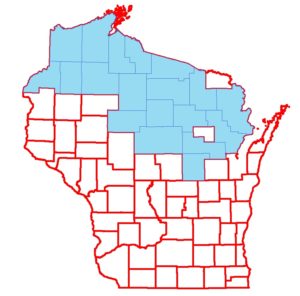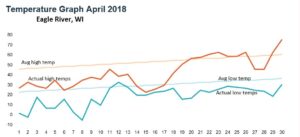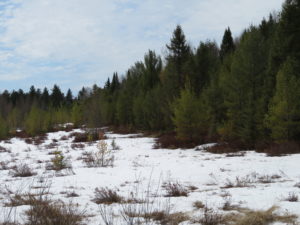
Counties shaded in blue are where balsam mortality has been reported, but it is even more widespread than this map indicates.
By Linda Williams, forest health specialist, Woodruff, Linda.Williams@wisconsin.gov, 920-360-0665 and Paul Cigan, forest health specialist, Hayward Paul.Cigan@wisconsin.gov, 715-416-4920
Reports of balsam fir suddenly turning rusty red to brown and dying have been coming in steadily this spring and summer. The accompanying map shows where this has been reported so far this year.
Spoiler alert! There are no insect or diseases involved. It appears the cause may be unusually severe winter drying or winter damage.
Symptoms were the same on all affected trees, regardless of location. Open-grown, understory, plantation, yard trees, forest trees, and Christmas trees (per DATCP) were all impacted. All sizes of balsam trees were affected – from seedling/saplings up to pole-sized trees. The top half to two-thirds of the tree died first, followed by the bottom part a few weeks later. During site visits, DNR forest health specialists found that 20-60% of balsam trees had symptoms. Often, dead trees were located next to seemingly healthy ones. Besides a few incidents of needlecast fungi, no pathogens or pests, including canker or root diseases, were observed in affected trees. Margins between dead tops and deteriorating bottoms of affected trees were not defined by canker margins; tops were simply dry and dead.
Although canker-like browning from bark beetle attack was present on some dying trees, this was not consistent from site-to-site. Last year’s long winter was interspersed with several sunny days, causing needles to lose moisture. However, the widespread mortality in balsam trees this year was worse than expected from normal winter burn.
All considered, winter drying is the likely cause of balsam fir mortality in the state. Although winter in northern Wisconsin was prolonged, by the end of April, snow began to melt and frost leave the ground. During the period between winter and spring weather, tree needles engaged in photosynthesis would have no way to replenish lost water from roots, which were still frozen. Very low relative humidity levels in late April caused needles to dry out even further, and temperatures in early May soared to the 70’s and 80’s. These things combined might have been too much for some balsam trees.

Weather data from Eagle River, WI weather station, April 2018. The combination of nighttime freezing and daytime thaws can cause needles to lose water and suffer freeze damage. Graphic from AccuWeather.com.

This picture was taken April 24, 2018, in Vilas County, when there was still a significant amount of snow on the ground.


